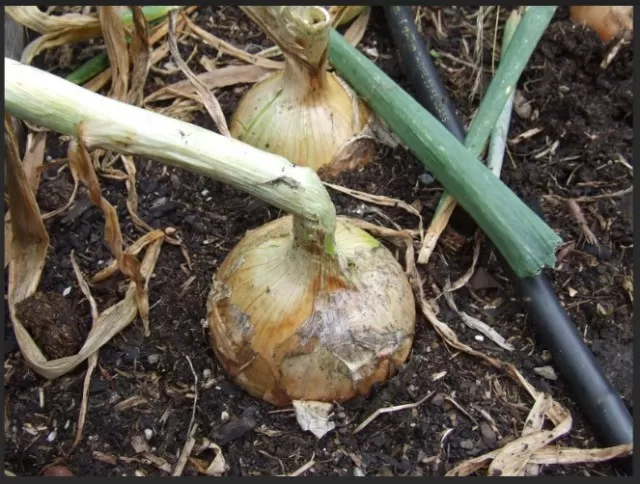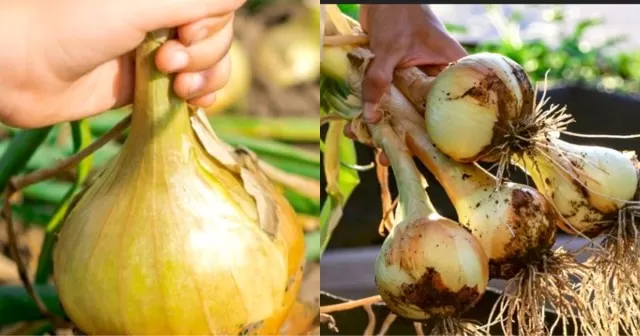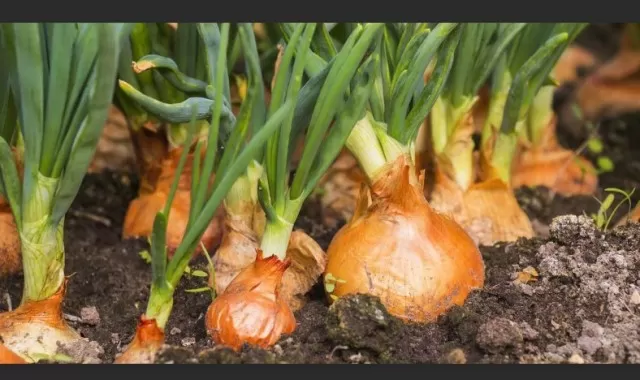Planting, Cultivating, and Harvesting Onions.Onions are an excellent choice for gardeners seeking a low-maintenance vegetable to cultivate in their gardens. These hardy bulbs require minimal attention once they are planted in the soil, making them a hassle-free addition to your garden. They can thrive in various conditions, including full sun and low-water environments, which means you won’t need to constantly monitor and water them.
One key consideration for a successful onion crop is providing ample spacing between the rows. Onions have a tendency to compete for both water and sunlight. To ensure their unhindered growth and development, it’s important to give them enough room to spread out. Proper spacing allows each onion bulb to access the resources it needs to thrive, resulting in healthier and more substantial harvests when summer arrives.
Growing onions not only provides you with a plentiful supply of fresh and flavorful ingredients for your culinary creations but also offers the satisfaction of cultivating your own food with minimal effort. Whether you’re an experienced gardener or a novice, the resilience and low-maintenance nature of onions make them an excellent choice for a successful and rewarding gardening experience. So, if you’re considering what to plant in your garden this year, don’t forget to include these versatile and easy-to-grow vegetables on your list. Enjoy the rich, earthy taste of homegrown onions as a delicious addition to your summer dishes.
Growing and Caring for Onions: Best Practices

.
Sunlight:Onions require full sun and a substantial amount of light, typically between 10 to 16 hours per day during the bulb formation stage, depending on the onion variety.
In cases where sufficient sunlight is not available, especially for year-round indoor cultivation, you can supplement the light with a grow light to meet the plant’s light requirements.
Soil and Fertilizer:To foster healthy onion growth, use fertile, moisture-rich soil that has been enriched with compost.
High nitrogen content in the soil is essential for robust development. Consider using a nutrient-rich fertilizer like SUPERthrive Organic All-Purpose Plant Food.
This type of fertilizer aids in nutrient absorption and water uptake. Apply it just before planting and then at four- to six-week intervals during the growing season.
Watering:During the seedling stage, it’s important to keep onion seedlings consistently moist.
However, once they reach maturity, they typically require approximately one inch of water each week. It’s crucial to strike a balance when it comes to watering.
Overwatering can lead to yellowing leaves and the risk of disease and rot, as onions have shallow roots. Conversely, under-watering should be avoided to prevent the base soil from drying out.
Pest Management:If you observe yellowing or wilting in your onion plants, it could be a sign of pest infestation, particularly by onion maggots, which infest the plant stems.
Be vigilant and take appropriate measures to address these infestations to ensure the health and vitality of your onion crop. The team at University of Minnesota Extension can provide guidance on managing such issues effectively.
Common Problems in Onion Cultivation and How to Address Them

Pests, Particularly Onion Maggots:.
Prevention: Implement a three- to four-year crop rotation strategy.
Onion maggots tend to overwinter in the soil, with adult flies emerging in early to mid-spring. If you consistently plant onions in the same location, it creates an ideal environment for these pests.
By rotating your onion family crops to different spots every few years, you disrupt their life cycle and reduce the risk of infestation.
Protective Measures: Consider using lightweight row covers over the freshly planted onion beds in early spring to further deter infestations.
Mildew, Specifically Downy Mildew:.
Symptoms: Downy mildew can cause onion plant leaves to yellow and develop brown patches, ultimately leading to leaf collapse.
While it doesn’t necessarily kill the plants, it can impact bulb size and yield.
Prevention and Management: To reduce the risk of downy mildew, practice crop rotation, ensuring that onions are not repeatedly grown in the same area.
Proper spacing between onion plants to allow for good air circulation is crucial. These measures help create less favorable conditions for the development of downy mildew, thus preserving the health and productivity of your onion crop.
Harvesting Onions and Proper Storage

Harvest Timing: Late summer is generally the ideal time to harvest onions.
You’ll know that they are mature and ready for harvesting when the tops turn yellow and start to fall or droop, according to Sabine H. Schoenberg, the host of Sabine’s New House on Smart Healthy green living.
Harvesting Technique: To harvest onions effectively, use a spading fork to undercut and gently lift the bulbs from the soil, as recommended by the team at University of Minnesota Extension.
Be cautious not to damage the bulbs during this process.
Weather Considerations: It’s important to avoid harvesting onions during wet conditions, as moisture can lead to rot during transport and storage.
Opt for dry weather when it’s time to harvest your onion crop.
Storage: After harvesting, allow the onions to dry in a cool, dry area within your home for a period.
For storage, follow these tips:.
Use mesh onion bags or store onions in a single layer in a Cardboard Box.
Ensure proper ventilation to prevent moisture buildup.
Keep onions away from apples and pears, as the ethylene gas produced by these fruits can affect the flavor and storage quality of many vegetables, including onions.
By following these steps, you can enjoy fresh, well-preserved onions for an extended period.
*The information is for reference only.